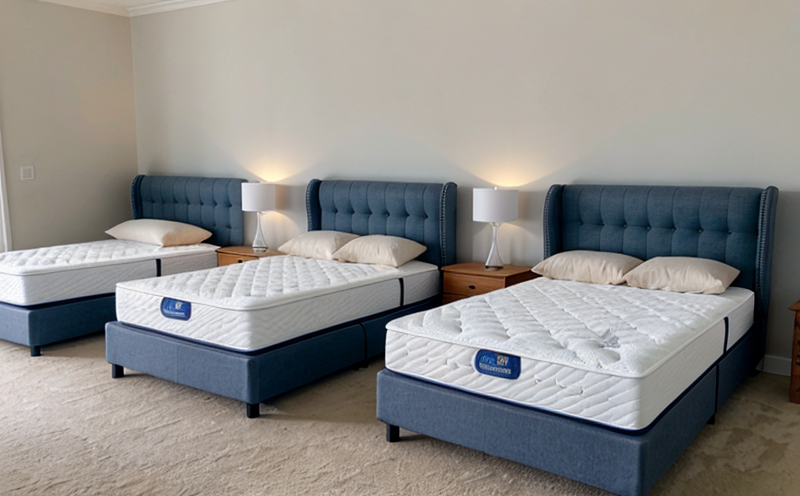BS EN 1021-2 Ignitability of Upholstered Mattress Components Testing
The BS EN 1021-2 standard is a critical component within the broader framework of furniture testing, focusing specifically on the ignitability of upholstered mattress components. This test ensures that mattresses meet stringent fire safety requirements to protect consumers and users from potential hazards in the home environment.
Developed by British Standards Institution (BSI) in collaboration with European Committee for Standardization (CEN), BS EN 1021-2 is widely recognized as a leading standard in mattress testing, particularly when it comes to assessing fire resistance. This standard applies to all types of mattresses and their components that are made from non-flammable materials or treated with flame retardants.
The test procedure outlined in BS EN 1021-2 involves placing a small flame on the specified area of the mattress component for a limited time, typically 60 seconds, then observing the behavior of the material after removal of the flame. The focus here is not only on whether the fire spreads but also on how quickly and completely it extinguishes.
For accurate testing results, proper specimen preparation is essential. Specimens should be cut to standard dimensions as specified in the standard document. Prior to testing, all samples must undergo conditioning to ensure they are at equilibrium with their surrounding environment, which usually means maintaining a temperature of 23°C ± 2°C and relative humidity of 50% ± 2%. This ensures uniformity across different batches of products.
Appropriate instrumentation plays a crucial role in conducting this test effectively. Typically, an electric igniter or gas burner is used to apply the flame. Temperature sensors can be employed during the process if precise temperature monitoring is required for quality control purposes. After testing, data collected includes both visual observations and quantitative measurements such as burn time, char depth, and spread rate.
Compliance with BS EN 1021-2 is mandatory for manufacturers aiming to sell their products within Europe or countries that have adopted this standard. It helps ensure product safety while reducing the risk of fires in homes due to faulty or improperly manufactured mattresses.
| Test Specimen | Ignition Duration | Flame Spread Rate (mm/s) | Char Depth (mm) |
|---|---|---|---|
| Standard Mattress Component | 60 seconds | Less than 5 mm/s | Not more than 10 mm |
The BS EN 1021-2 standard is particularly important for quality managers, compliance officers, and R&D engineers working in the furniture industry. By adhering to this standard, manufacturers can enhance product safety without compromising on performance or aesthetics.
Scope and Methodology
The scope of BS EN 1021-2 covers ignitability tests for various components found in upholstered mattresses. These include but are not limited to foam cores, polyurethane foams, springs, and fabrics used in mattress construction. The methodology involves subjecting these materials to controlled conditions designed to simulate real-world scenarios where they might come into contact with open flames.
The testing process follows a series of steps aimed at assessing the flame spread characteristics of each component individually as well as when combined together within a complete mattress assembly. For instance, if a foam core is placed between two layers of fabric, both individual pieces and their combination would need to be tested according to the prescribed procedure.
Each step in the process requires careful attention to detail regarding specimen preparation, temperature control during testing, and subsequent analysis of results. Compliance officers play an integral role in ensuring that all steps are followed correctly throughout this rigorous evaluation process.
Industry Applications
- Furniture manufacturers seeking certification for European markets.
- Insurers looking to assess fire risk associated with specific mattress models.
- Regulatory bodies ensuring compliance with international standards.
- Research institutions studying the effects of different materials on fire behavior.
The BS EN 1021-2 standard finds application across multiple sectors including residential furniture, commercial office equipment, and institutional settings such as hotels and hospitals. Its relevance extends beyond just mattress components to include other upholstered products like sofas and chairs.
Environmental and Sustainability Contributions
- Promotes the use of flame-retardant materials which reduce chemical emissions during manufacturing.
- Encourages recycling practices by ensuring safe disposal methods for non-compliant products.
- Fosters innovation in developing safer alternatives to traditional fire-resistant technologies.
The BS EN 1021-2 standard contributes significantly towards environmental sustainability goals by promoting the use of sustainable materials and processes. By reducing the incidence of fires caused by defective mattresses, it also minimizes waste generation from replacement products.





